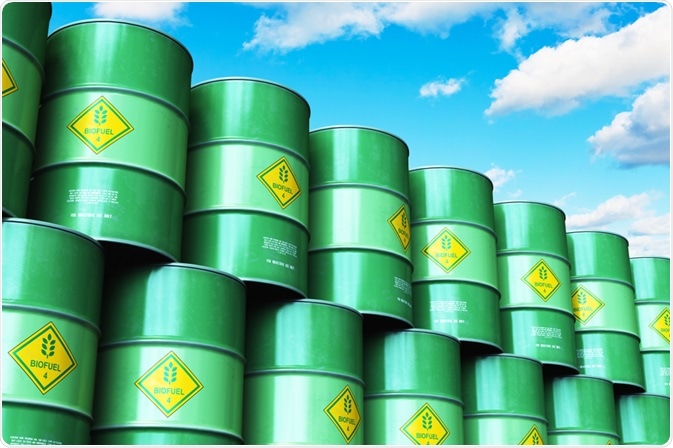
Global Biodiesel Market (2022 to 2027) – Growth, Trends, COVID-19 Impact and Forecasts
DUBLIN–(BUSINESS WIRE)–The “Biodiesel Market – Growth, Trends, COVID-19 Impact, and Forecasts (2022 – 2027)” report has been added to ResearchAndMarkets.com’s offering.
The market for biodiesel is expected to grow at a CAGR of more than 7.98% during the forecast period of 2022-2027.
Companies Mentioned
- Renewable Energy Group, Inc
- Archer Daniels Midland Company
- Bangchak Corporation Public Company Limited
- Wilmar International Ltd
- Neste Oyj
- Cargill Inc
- BIOX Corporation
- Ag Processing, Inc.
Key Market Trends
Transportation Segment Expected to Dominate the Market
- Biodiesel is a renewable, clean-burning diesel replacement used in existing diesel engines without modification. It is made from an increasingly diverse mix of recycled cooking oil, agricultural feedstock, and animal fats.
- The United States is a significant consumer of biodiesel. Some local, state, and federal government agencies with fleets of school and transit buses, snowplows, garbage trucks, mail trucks, and military vehicles use biodiesel blends, usually B20. Fuelling stations that sell biodiesel blends of B20 or higher to the public are available in almost every state.
- In Q1 2021, Germany had exported around 933,117 tonnes of biodiesel. The primary consumers of German biodiesel were European Union countries (88%), headed by the Netherlands, Poland, and Belgium.
- Moreover, in May 2021, the German government had introduced new biofuel law. As per the new law, obligated oil companies will have to significantly increase the use of biodiesel, bioethanol, and biomethane in the transportation sector to reduce carbon emissions.
- As of 2020, global biodiesel consumption has reached almost 682 thousand barrels of oil equivalent per day, which is comparatively higher than 464 thousand barrels of oil equivalent per day as of 2015.
- Due to the fluctuating prices of petroleum-based products, biodiesel is becoming an increasingly affordable option. The share of biodiesel in transportation fuel is expected to increase considerably.
Asia-Pacific to Witness Significant Growth
- Asia-Pacific is the second-largest consumer of biodiesel across the globe. In 2020, the region consumed 170 thousand barrels of oil equivalent per day. Countries like China, Indonesia, India, Vietnam are promoting the use of bio-diesel to reduce GHG emissions.
- Indonesia became the first nation to mandate a B30 blend of palm-based fuel. The government allocated 9.59 million kiloliters of Fatty Acid Methyl Ester (FAME) for the B30 mandate in 2020, up from 6.63 million KL in 2019.
- In the year 2020, the Indonesian government allocated USD 195 million from the state budget to subsidize producers of palm oil biodiesel to boost the economy out of a pandemic-induced slump.
- On the other hand, in Malaysia, the mandate to manufacture biofuel with a 20% palm oil component – known as B20 witnessed a delay. The mandate is expected to be implemented across the country by the end of 2022.
- With three new biodiesel plants installed in India in 2019, the total number of plants increased to 26 as of 2021. The additional plants have increased the capacity significantly, and with upcoming projects in line, the production is likely to increase further in India.
- Moreover, in December 2021, LRE Petroleum received the letter of intent (LOI) from Indian Oil to set up a biodiesel manufacturing plant in India. The plant is located in Karnataka and is capable of producing 4 million liters of biodiesel (B-100) every year.
- Hence with the increasing blend percentage in countries like Malaysia, Thailand, and India, the Asia-Pacific region is expected to witness the highest growth rate in the forecast period.
Key Topics Covered:
1 INTRODUCTION
2 RESEARCH METHODOLOGY
3 EXECUTIVE SUMMARY
4 MARKET OVERVIEW
4.1 Introduction
4.2 Market Size and Demand Forecast in USD billion, till 2027
4.3 Recent Trends and Developments
4.4 Government Policies and Regulations
4.5 Market Dynamics
4.5.1 Drivers
4.5.2 Restraints
4.6 Supply Chain Analysis
4.7 Porter’s Five Forces Analysis
5 MARKET SEGMENTATION
5.1 Feedstock
5.1.1 Vegetable Oil
5.1.2 Animal Fat
5.1.3 Others
5.2 Application
5.2.1 Transportation
5.2.2 Power Generation
5.2.3 Others
5.3 Geography
6 COMPETITIVE LANDSCAPE
6.1 Mergers and Acquisitions, Joint Ventures, Collaborations, and Agreements
6.2 Strategies Adopted by Leading Players
6.3 Company Profiles
7 MARKET OPPORTUNITIES AND FUTURE TRENDS
For more information about this report visit https://www.researchandmarkets.com/r/t29fgr
Contacts
ResearchAndMarkets.com
Laura Wood, Senior Press Manager
press@researchandmarkets.com
For E.S.T Office Hours Call 1-917-300-0470
For U.S./CAN Toll Free Call 1-800-526-8630
For GMT Office Hours Call +353-1-416-8900


